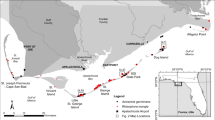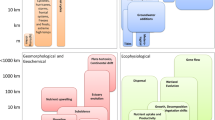Abstract
The interplay between mangroves and saltmarshes at the temperate to subtropical transition in Florida results in dramatic changes to the appearance of the coastal landscape. In the 1980s, freezes killed entire mangrove forests dominated by black mangroves, Avicennia germinans (L.). Following the freezes, saltmarshes dominated by smooth cordgrass, Spartina alterniflora Loisel, revegetated the intertidal zone. After a decade of mild winters, however, mangroves are beginning to reclaim the area. The rate of mangrove expansion was determined by comparing aerial photography (change from 1995 to 1999), and from monitoring transects (over a 3 year period) on three of the Cedar Keys, Florida (Lat. 29°08′). The rate of mangrove expansion varied among islands, and the mechanism of expansion ranged from propagule-trapping by saltmarshes along the edges of mangrove clumps to widespread dispersal and growth of existing or newly imported propagules. A freeze occurred during the study, which may have set back mangrove expansion by defoliating mangrove trees and resetting mangrove reproduction. Mangrove expansion was projected to take 20–30 years for complete seedling cover. Given the possibility of global climate change and its potential influence on the distribution of coastal vegetation, the timeframes and implications to coastal wetland ecosystems involved in this regular interplay will provide valuable baseline information for future studies.
Similar content being viewed by others
References
J.W. Beever D. Simberloff L.L. King (1979) ArticleTitleHerbivory and predation by the mangrove tree crab Aratus pisonii Oecologia 43 317–328 Occurrence Handle10.1007/BF00344958
J. Blanchard G. Prado (1995) ArticleTitleNatural regeneration of Rhizophora mangle in strip clearcuts in Northwest Ecuador Biotropica 27 160–167 Occurrence Handle10.2307/2388991
P.J. Clarke W.G. Allaway (1993) ArticleTitleThe regeneration niche of the grey mangrove (Avicennia marina): effects of salinity, lightand sediment factors on establishmentgrowthand survival in the field Oecologia 93 548–556 Occurrence Handle10.1007/BF00328964
P.J. Clarke P.J. Myerscough (1993) ArticleTitleThe intertidal distribution of the grey mangrove (Avicennia marina) in southeastern Australia: the effects of physical conditions, interspecific competition, and predation on propagule establishment and survival Aust. J. Ecol. 18 307–315 Occurrence Handle10.1111/j.1442-9993.1993.tb00458.x
J. Clarke (1997) Atlantic Pilot Atlas International Marine Camden, ME
Davis J.H. 1940. The ecology and geologic role of mangroves in Florida. Papers from Tortugas Lab, 32.
W.P. Davis D.S. Taylor B.J. Turner (1995) ArticleTitleDoes the autecology of the mangrove rivulus fish (Rivulus marmoratus) reflect a paradigm for mangrove ecosystem sensitivity? Bull. Mar. Sci. 57 208–214
C.B. Higinbotham M. Alber A.G. Chalmers (2004) ArticleTitleAnalysis of tidal marsh vegetation patterns in two Georgia estuaries using aerial photography and GIS Estuaries 27 670–683 Occurrence Handle10.1007/BF02907652
P.C. Kangas A.E. Lugo (1990) ArticleTitleThe distribution of mangroves and saltmarsh in Florida J. Trop. Ecol. 31 32–39
A.M. Laessle C.H. Wharton (1959) ArticleTitleNorthern extensions in the recorded ranges of plants on Sea Horse Key and associated Key, Levy County, Florida Q. J. Fla. Acad. Sci. 22 105–113
R.R. Lewis F.M. Dunston (1975) The possible role of Spartina alterniflora Loisel in establishment of mangroves in Florida R.R. Lewis (Eds) Proceedings 2nd Annual Conference on Restoration of Coastal Vegetation in Florida Hillsborough Community College Tampa, FL 82–100
A.E. Lugo C.P. Patterson-Zucca (1977) ArticleTitleThe impact of low temperature stress on mangrove structure and growth Trop. Ecol. 18 149–160
J.L. Markley C. McMillian G.A. Thompson SuffixJr. (1982) ArticleTitleLatitudinal differentation in response to chilling temperatures among populations of three mangroves, Avicennia germinans, Laguncularia racemosa, and Rhizophora manglefrom the western tropical Atlantic and Pacific Panama Can. J. Bot. 60 2704–2715 Occurrence Handle1:CAS:528:DyaL3sXht1ejtL0%3D
K.L. McKee (1995) ArticleTitleSeedling recruitment patterns in a Belizean mangrove forest: effects of establishment ability and physico-chemical factors Oecologia 101 448–460 Occurrence Handle10.1007/BF00329423
C. McMillan C.L. Sherrod (1986) ArticleTitleThe chilling tolerance of black mangroveAvicennia germinansfrom the Gulf of Mexico coast of Texas, Louisianaand Florida Contrib. Mar. Sci. 29 9–16
K.A. Miller M.W. Downton (1992) ArticleTitleThe freeze risk to Florida citrus. Part I: investment decisions J. Clim. 6 354–363 Occurrence Handle10.1175/1520-0442(1993)006<0354:TFRTFC>2.0.CO;2
C.L. Montague R.G. Weigert (1990) Saltmarshes R. Myers J. Ewel (Eds) Ecosystems of Florida University of Central Florida Press Orlando, FL 481–516
C.L. Montague H.T. Odum (1997) The intertidal marshes of Florida’s Gulf Coast C.L. Coultas Y.P. Hsieh (Eds) Ecology and Management of Tidal Marshes: A Model from the Gulf of Mexico St. Lucie Press Delray Beach, FL 1–33
InstitutionalAuthorNameNational Oceanic and Atmospheric Administration (NOAA) (1915–1997) Climatological Data Florida Section, National Climatic Center Asheville, North Carolina
National Oceanic and Atmospheric Administration (NOAA) 1985. Gulf of Mexico: Coast and Ocean Zones: Strategic Assessment: Data Atlas.
National Oceanic and Atmospheric Administration (NOAA). 1988. Sea-level variations for the U.S. 1855–1986.
W.E. Odum (1983) Systems Ecology John Wiley and Sons New York, NY 644
W.E. Odum C.C. McIvor T.J. Smith SuffixIII (1982) The ecology of the mangroves of south Florida: a community profile U.S. Fish and Wildlife ServiceOffice of Biological Services Washington, DC 144
C.S. Patterson I.A. Mendelssohn (1991) ArticleTitleA comparison of physiochemical variables across plant zones in a mangal/salt marsh community in Louisiana Wetlands 11 139–161 Occurrence Handle10.1007/BF03160845
C.S. Patterson I.A. Mendelssohn E.M. Swenson (1993) ArticleTitleGrowth and survival of Avicennia germinans seedlings in a mangal/salt marsh community in LouisianaUSA J. Coast. Res. 9 801–810
W. Post J.S. Greenlaw (1994) Seaside sparrow, No. 127 A. Poole F. Gill (Eds) The Birds of North America The American Ornithologists Union and the Academy of Natural Science of Philadelphia Philadelphia, PA
N. Saintilan R.J. Williams (1999) ArticleTitleMangrove transgression into saltmarsh environments in south-east Australia Glob. Ecol. Biogeogr. 8 117–124 Occurrence Handle10.1046/j.1365-2699.1999.00133.x
Stout J.P. 1984. The ecology of irregularly flooded saltmarshes of the northeastern Gulf of Mexico: a community profile. U.S. Fish and Wildlife ServiceOffice of Biological Services, Washington DC, 85 (7.1), 98 pp.
D.S. Taylor (1993) ArticleTitleNotes on the impact of the December 1989 freeze on local populations of Rivulus marmoratus in Florida, with additional distribution records in the state Fla. Sci. 56 129–134
D.S. Taylor W.P. Davis B.J. Turner (1995) ArticleTitleRivulus marmoratus: ecology of distributional patterns in Florida and the central Indian River Lagoon Bull. Mar. Sci. 57 202–207
H.R. Wanless R.W. Parkinson L.P. Tedesco (1994) Sea level control on stability of Everglades wetlands S.M. Davis J.C. Ogden (Eds) Everglades: The Ecosystem and its Restoration St. Lucie Press Delray Beach, FL 199–223
Watson A.M. 1986. Nutrient-production relations at Seahorse Key Lagoon, Florida: some consequences of shorebird accumulations. M.S. Thesis, University of Florida, Gainesville, FL, 87 pp.
M.D. Winsberg (1990) Florida Weather University of Central Florida Press Orlando, FL
Author information
Authors and Affiliations
Corresponding author
Rights and permissions
About this article
Cite this article
Stevens, P.W., Fox, S.L. & Montague, C.L. The interplay between mangroves and saltmarshes at the transition between temperate and subtropical climate in Florida. Wetlands Ecol Manage 14, 435–444 (2006). https://doi.org/10.1007/s11273-006-0006-3
Received:
Accepted:
Issue Date:
DOI: https://doi.org/10.1007/s11273-006-0006-3




